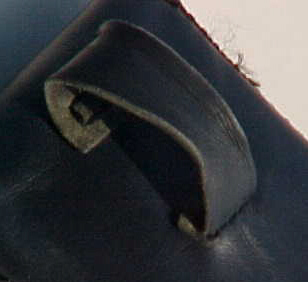
[Title] [text TOC] [image TOC] [Site Search]
 [Donation]
[Donation]

 [Donation]
[Donation]
 |
Pouch Belt Loop |  |
|---|

See the Leather Chapter for more instructions, hints, tips, and ideas.
The belt in the photo above was made with both ends of loop tucked under. This is harder to do than the method described below because there is not much clearance for the needle.
Use waxed thread for the stitching and a thonging chisel to make the holes.
The belt loop should be sewn on the pouch before the pouch is assembled. If you do it after the pouch is assembled you will have a difficult time working inside the pouch to do the stitching.
The top attachment point for a belt loop should be attached near the top of the pouch. The bottom attachment point should be above the middle of the pouch if possible. If the belt loop is lower on the pouch the pouch may try to turn upside down.
Punch the holes in both the belt loop and pouch. The number of holes doesn't matter, but they should span the width of the belt loop. As long as you have two rows with the same number of holes in each row, the stitching instructions below will work. See the illustrations below. The top attachment point is made with the belt loop back side out.


Stitch the top attachment first. Start the stitching from what will be the inside of the pouch. See the illustrations below. Tighten the thread after every stitch. First go into hole 1, out hole 2, in 3, out 4, in 5, and out 6. Now it should look like the second illustration. Now go back in 5, out 4, in 3, out 2, in 1, and out 6. Finally tie a square knot to hold the stitches tight.



You won't need much space for a belt to go through the loop, so position the bottom attachment point so that the loop lays flat on the pouch. The one in the photo above is way too loose. If you make the loop too loose, the pouch will flop as you walk.
Lastly, stitch the bottom attachment in the same manner.